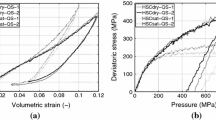Abstract
An experimental investigation was undertaken to analyze the influence of various admixtures on the rheological properties and scaling resistance of self-consolidating concrete. Such concrete is intended for use as a repair material for filling highly restricted areas, such as forms with closely spaced reinforcing steel bars. Several self-consolidating concrete mixtures having slump flow of 550+50 mm were prepared with water-to-cement ratios varying between 0.35 and 0.41. The mixtures were cast with 0 and 3 percent silica fume, with and without air-entraining admixture. All concretes incorporated superplasticizer and viscosity-modifying admixture to enhance deformability and stability. Rheological parameters (yield value and plastic viscosity) were measured using a concrete viscometer. The air content, unit weight, and consistency were also determined. The consistency was assessed using the slump flow and L-Flow methods. Tests performed on hardened concrete included compressive strength at 28 days (ASTM C 39), scaling resistance (ASTM C 672), durability to freezing and thawing (ASTM C 666) and measurement of the air-void parameters (ASTM C 457).
Relationship between the simple slump flow and yield value and plastic viscosity measurements determined using a concrete viscometer are also discussed. In general, the laboratory test results indicate that it is possible to produce a frost durable, self-consolidating concrete with low yield value and high plastic viscosity (for such fluid concrete) which can be use as a repair material to fill highly restricted areas.
Résumé
Des essais en laboratoire ont été réalisés afin de vérifier l'influence de différents adjuvants sur les propriétés rhéologiques et la résistance à l'écaillage en présence de sels fondants de bétons autonivelants. Ce type de béton possède une grande fluidité et une bonne résistance à la ségrégation, d'où sa grande utilité dans les coffrages très ferraillés et dans les endroits difficiles d'accès tels les réparations en surplomb. Lors de ces travaux de recherche, plusieurs bétons auto-nivelants avec un étalement de 550±50 mm ont été fabriqués. Ces bétons avaient un rapport eau-liant variant de 0,35 à 0,41. Tous les mélanges contenaient un superplastifiant et un agent colloïdal modifiant la viscosité. Les différentes variables étudiées étaient: la présence de fumée de silice (0 et 3%), le dosage en superplastifiant et la présence d'un agent entraîneur d'air. Les paramètres rhéologiques tels le seuile de cisaillement et la viscosité plastique ont été mesurés à l'aide d'un rhéomètre à béton. La teneur en air, la masse volumique et la fluidité ont aussi été mesurées. La fluidité a été mesurée à partir des essais d'affaissement, d'étalement et d'un appareil spécial appelé appareil en L. Des essais de résistance à la compression (ASTM C 39), de résistance à l'écaillage en présence de sels fondants (ASTM C 672), de geldégel (ASTM C 666) et des mesures des caractéristiques de vides d'air (ASTM C 457) ont été effectués sur le béton durci.
Des relations entre l'écoulement, le seuil de cisaillement et la viscosité plastique mesurée avec le rhéomètre à béton sont présentées. En règle générale, les résultats des essais de laboratoire ont montré que les bétons autonivelants étudiés, possédant un seuil de cisaillement faible et une viscosité plastique élevée, possèdent une excellente durabilité au gel et peuvent être utilisés en tant que matériau de réparation dans les endroits difficiles d'accès.
Similar content being viewed by others
References
Hayakawa, M., Matsuoka, Y. and Shindoh, T., ‘Development and Application of Superworkable Concrete’, Proceedings of an International RILEM Workshop on Special Concrete: Workability and Mixing, March 1993, Scotland, (University of Paisley, Scotland) 183–190.
Khayat, K. H., ‘Effects of anti-washout admixtures on fresh concrete properties’,ACI Materials Journal 92 (2) (1995) 164–171.
Khayat, K. H. and Guizani, Z., ‘Use of viscosity-modifying admixtures to enhance stability of highly fluid concrete’94 (4) (1997) 332–340.
Khayat, K. H., Manai, K. and Trudel, A., ‘In-situ mechanical properties of wall elements cast using self-consolidating concrete’94 (6) (1997) 491–500.
Beaupré, D. and Mindess, S., ‘Compaction of Wet Shotcrete and its Effect on Rheological Properties’, Proceedings of an International Symposium on Sprayed Concrete, October 1993, Fagernes (Norway), 167–181.
Tattersall, G. H., ‘Workability and Quality Control of Concrete’ (Chapman & Hall, London, 1991)
Tattersall, G. H. and Banfill, P. F. G., ‘The Rheology of Fresh Concrete (Pitman Publications, London, 1983)
Domone, P. L. and Chai, H. W., ‘Design and Testing of Self-Compacting Concrete’, Proceedings of an International RILEM Conference on Production Method and Workability of Concrete, June 1996, Paisley (Scotland) 223–236.
Peterson, O., ‘Flowing Concrete’, Proceedings of an International RILEM Seminar on Workability of Special Concretes and Efficiency of Concrete Mixers, May 1995, Stockholm, (Sweden), 5 p.
Peterson, O., ‘A Model for Self Compacting Concrete’, Proceedings of an International RILEM Conference on Production Method and Workability of Concrete, June 1996, Paisley (Scottland) 483–492.
McLeish, A., ‘Evaluating the Flow Properties of Flowable Concrete’, Proceedings of an International RILEM Workshop on Special Concrete: Workability and Mixing, March 1993, Scotland (University of Paisley, Scotland) 249–257.
Mitsui, K., Yonzawa, T., Kinoshita, M. and Shimono, T., ‘Application of a New Superplasticizer to Ultra High Strength Concrete’, Proceedings of an ACI seminar on Superplasticisers in Concrete, Detroit (American Concrete Institute, Detroit, USA) SP-148, 27–45.
Author information
Authors and Affiliations
Rights and permissions
About this article
Cite this article
Beaupré, D., Lacombe, P. & Khayat, K.H. Laboratory investigation of rheological properties and scaling resistance of air entrained self-consolidating concrete. Mat. Struct. 32, 235–240 (1999). https://doi.org/10.1007/BF02481521
Received:
Accepted:
Issue Date:
DOI: https://doi.org/10.1007/BF02481521




